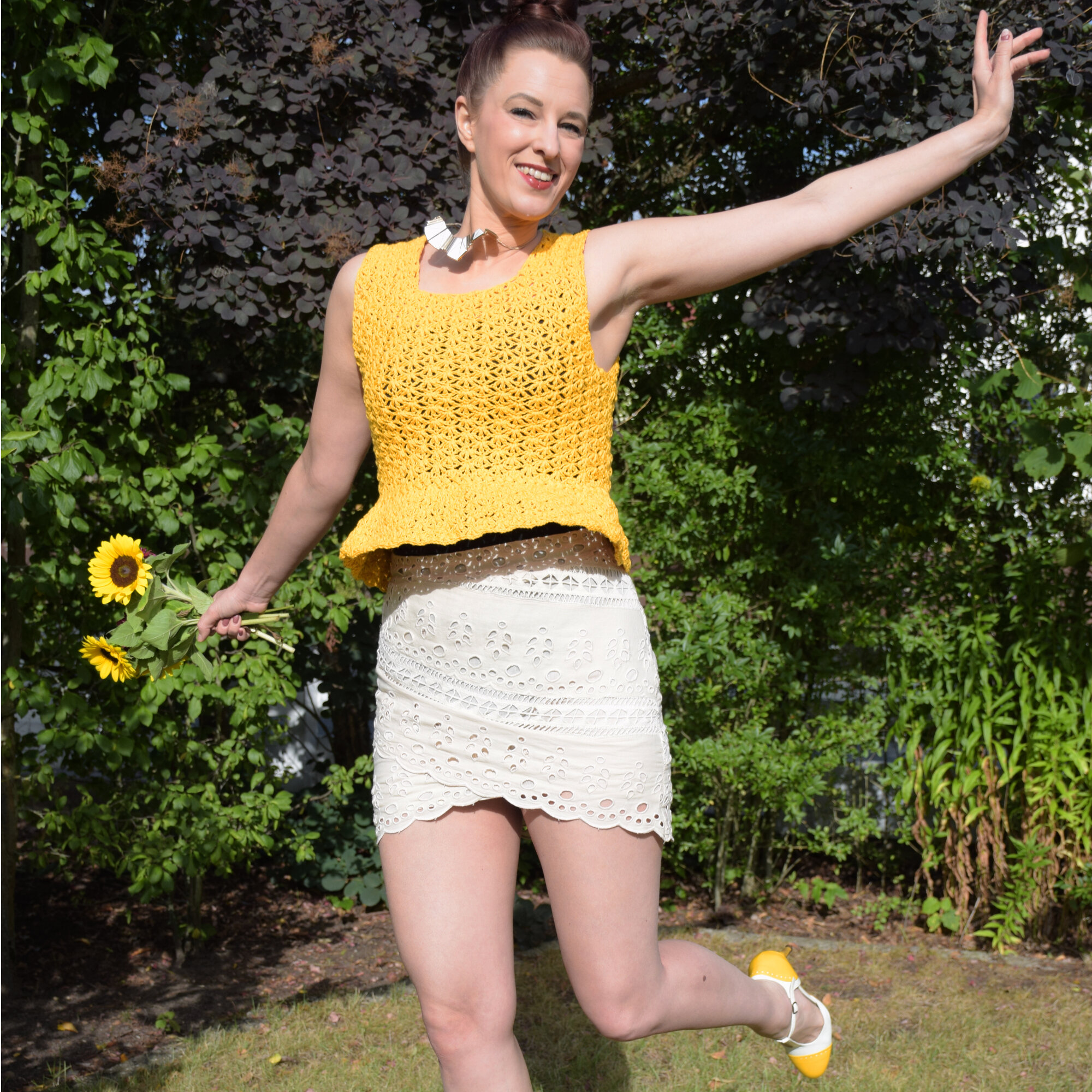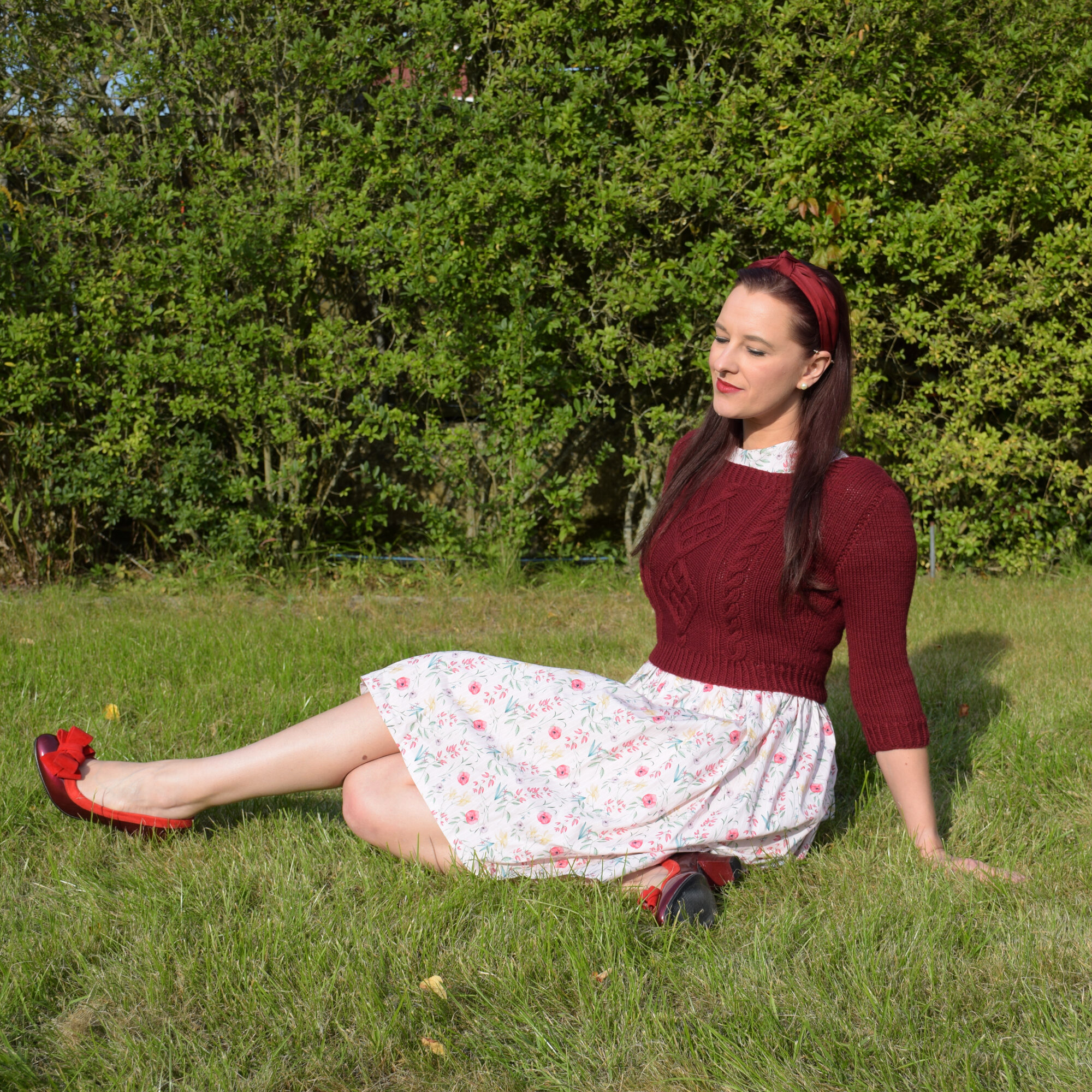Pattern Testing with Budget Yarns
By @RomyDandelion
Today’s guest post is written by a fellow co-tester, Romy of @RomyDandelion! Romy is here to talk to you about pattern testing with budget yarns. I am a huge fan of budget yarns! Ain’t no shame in my acrylic game. So, please enjoy this lovely post and then go show Romy some love on Instagram!
Romy is pictured above wearing the Agatha Top by @gorillaknits using Stylecraft Special Aran
Hi everybody! My name is Romy and I am a crafter from northern Germany. I love to knit, crochet and sew, and not too long ago, I got into testing knit/crochet patterns for designers. At first I was a bit hesitant to apply because I knew that, being a student, I wouldn’t be able to afford hand-dyed yarn to test designers’ patterns. I thought to myself: Would they even accept me if I used affordable yarn? What will the other testers think if I showed them the acrylic yarn I’m planning on using for the test?
I’d love to share some of my thoughts and feelings about (test) knitting/crocheting with budget yarn in the following blog post.
I also want to give a big shout out to Brit @themarvelousmrsmaker, Laura @murphymadecrochet and Shanese @handcraftedbyshanese who were kind enough to answer some questions about budget yarns and whom I will be quoting regarding some elements of this blog post. Thank you ladies! ❤
Romy is pictured above wearing the Cherry Blossom Top by @therealjourneychaneldesign using Paintbox DK; the Afterglow Top by @themarvelousmrsmaker using Sirdir Cotton; the Chuck Sweater by @untangling.knots using Cascade 220; and the Tropicana Twist by @themarvelousmrsmaker using Cascade 220 Superwash.
♡♡♡
So, what exactly do I mean when I talk about “budget yarns”? Budget yarns obviously can mean different things to different people. Some might say that anything under 3 €/ ~ 3.60 $ per skein fits this category. Others might consider all yarns that are not indie-dyed budget yarns. What I have gathered from interviewing my lovely fibre friends is that budget yarn is usually something that is readily available – either online or in shops (Do you remember when it was possible to just pop into a shop and stroke some beautiful yarn?! No? Me neither). I also feel like fibre composition plays a big role in determining what is considered to be a budget yarn. Acrylic seems to come to mind first as a budget friendly option since it is sold at a very low price. (Merino) wool, cashmere or silk on the other hand are mostly referred to as luxurious and high-end. I mostly knit garments, so for me, any sweater quantities of yarn that add up to less than 35 € /~ 42 $ (wool/cotton) or 20 €/ /~ 25 $ (acrylic) is a budget yarn.
My initial doubts about testing patterns using budget yarns were absolutely unnecessary. I never had a designer tell me that I couldn’t be part of a testing group just because I wanted to work with affordable yarn. All designers I’ve tested for do their best to offer suggestions for affordable yarns that have the same properties as the yarn they chose for their design. Jessie of @jessssiemae, for example, is a designer who offers knitters a whole Excel sheet containing budget friendly options. I wasn’t able to participate in a test knit once since the designer had a contract with a brand and their (pricey) yarn needed to be used for testing. I completely understand that designers need to make a living and rely on sponsorships, so it wasn’t a big deal for me that I couldn’t take part in this particular test.
I’ve also never gotten nasty comments from other testers about my yarn choices. The testing groups have always been very encouraging and open towards budget yarns. To be honest, nobody really cared much about the fibre content. I’m aware that yarn snobbery is a thing in the knitting/crocheting community.
Brit of @themarvelousmrsmaker remarked that “yarn snobbery, in my opinion, has been a matter of hand dyed luxury yarn vs. all else, which really boils it down to classism, and I’m just not cool with that”.
Word! I absolutely agree. One could possibly write a whole separate blog post about what is wrong with yarn snobbery, but these are my two cents: If you can afford luxury yarns and that’s what you want to use for your project, by all means, go for it! But putting people down for not being able to spend 100 € on a sweater project does not increase your self-worth - it just makes you a horrible person.
Yarn snobbery is also the reason some makers consider their projects not to be “good enough”. Believe me, I’ve been there. I felt like my project wasn’t as special or as fancy as those knitted with hand-dyed or high-end yarns and that it wasn’t worth sharing on social media. It is not about how much you spend on your yarn or which fibre it contains. It’s about the love you pour into a garment when making it and the memories you associate with it every time you look at it. My Cherry Blossom Peplum top by @therealjourneychaneldesign will always remind me of those warm summer nights sitting on my balcony, drinking a gin & tonic and crocheting. It’s the experience that makes the garment special. You won’t look at a garment and think, “Oh that’s the top I knit with a ball of acrylic yarn”, you will look at it and think, “Heck yeah, I had the best time with my friends at the beach wearing this top”.
Your garment also showcases your amazing skills and talent, no matter what yarn you chose to knit it with.
My friend Laura of @murphymadecrochet put it perfectly: “A sweater made with a cashmere blend requires no more skill than one knit with acrylic”.
Focus on what makes this garment special to YOU and what it says about YOUR skills instead of wasting energy thinking about if people might judge you because you chose to knit/crochet with acrylic yarn.
Since I’ve talked about budget yarns so much in this blog post (who counted how many times I’ve written budget yarns?) I now want to share some favourite yarn brands with you that fit the budget yarn category:
My favourite budget yarn is Cascade 200 (worsted weight). It comes in a million colours, works up nicely and appears to be quite durable (that’s my experience at least).
I also really like to work with Stylecraft Special DK and Paintbox yarns.
Laura of @murphymadecrochet recommends all yarns from WeCrochet, especially stroll, hawthorn, muse fingering weight and the tweed options.
Lion Brand Heartland and Premier Yarns Anti-Pilling are some of Shanese’s of @handcraftedbyshanese favourites.
Brit @themarvelousmrsmaker is a fan of Knit Picks Shine Sport which is a pima cotton with amazing drape and colour variety.
I’m sure there are tons more budget options out there and it makes me so happy to know that those are available to everyone who has the skills and enjoys working with yarn. Budget yarns make you no less of a maker / pattern tester. So, if you are thinking about applying for a test knit/crochet but you are afraid of what people might think about your affordable yarn choice – DO IT! It’ll be absolutely worth it and you’ll find that the people you meet in the testing groups don’t care about the fibre content of your yarn – they only care about the content of your heart.
♡♡♡
I don’t know about you, but I really enjoyed this post by Romy of @RomyDandelion! She is absolutely correct. Budget-friendly yarns make you no less of a maker, and they make your projects no less special. Some of my favorite handmade items are made with Lion Brand Heartland and other acrylic yarns, and I cherish those just as much as my “fancy yarn” makes, sometimes more. So, as Romy said, don’t let this hold you back from pattern testing! We want to see your makes! And using a budget-friendly yarn for a pattern test helps market the pattern as being more accessible to others too, which only helps the designer.
Please go show Romy some love on Instagram for this special post!




